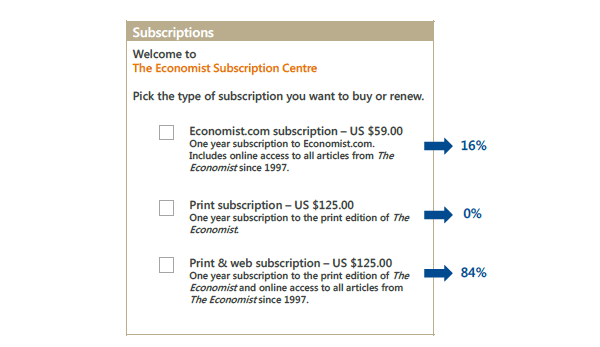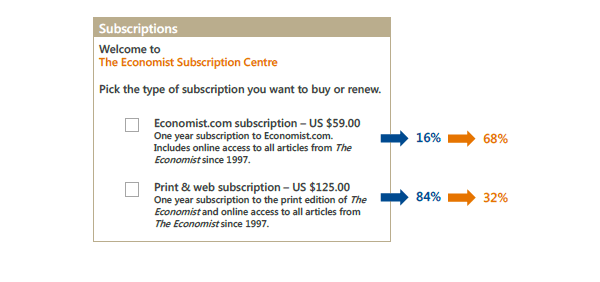Market researchers are dogged by nagging doubts. We ask someone why they bought their red Porsche and they tell us that it was because they value reliability. What can we make of that? Can we believe them? Equally, if we say to someone “what drives your choice of chemical supplier?” and they tell us that it is price, quality and delivery, again, how much of what they say can we believe, especially if we learn that they have remained faithful to their incumbent supplier for the last 10 years? In other words, to what extent is what people say, what they actually mean and what drives their behaviour?
What Is Behavioural Economics?
As the words suggest, behavioural economics focuses on what we do (how we behave) and not necessarily on what we say or think. The “economics” component of the title acknowledges that somewhere in our behaviour there are trade-offs. However, at the heart of behavioural economics is the notion that heuristics (that is bias based on experience) significantly affects our decisions.
Behavioural economics is interested in the same question that classical economics is interested in, except it doesn’t believe that decisions are made rationally. Whereas classical economists compute outcomes based on theoretical perfection, behavioural economics accepts the myopic and irrational decision-making of human beings and arrives at explanations through experiments and observations. In standard economics it is assumed that the human condition is all knowing whereas in behavioural economics we assume that mistakes are made all the time. If we recognise these imperfections in the real world we can figure out where people don’t behave perfectly, and better understand how we can adjust and even manipulate people’s behaviour.
A traditionally trained economist would have us believe that the economic world is driven towards an equilibrium based on logic and rational forces. These frameworks and theories are extremely useful in helping us understand the mechanisms of markets. However, the real world isn’t as logical as economists would have us believe. People make decisions often without full knowledge of alternative products and prices and most probably with a certain amount of bias. Inevitably this influences their decisions. So, our chemical buyer, when answering the question “what drives the choice of supplier?” will not necessarily know the prices, product availability and service levels of all the potential suppliers. Furthermore, they may be concerned that some of the potential suppliers could let them down and they may prefer to trust the devil they know. They may even believe that switching suppliers could risk a failure of one kind or another that could reflect badly on their decision.
The Way We Ask Questions Affects The Answers We Are Given
Take, for example, the subject of organ donations. If we ask people what they think of donating their organs, a high proportion will agree in principle that they would do so. However, if we observe the behaviour of people who actually do sign up for donor cards, we get a completely different answer. This is exemplified in the following diagram, which shows the differences in the agreement to donate organs from various authorities responsible for issuing driving licences in a number of countries. This is an occasion when people are confronted with an invitation to become a donor. We see a huge contrast between countries that we would think have similar views on organ donation. In Austria, 100% of vehicle drivers have signed up to donate their organs and in Germany the proportion is very small indeed.

The explanation for these differences is the way the question was asked. Austrian licence owners are shown a question which invites them to tick a box if they are not prepared to donate their organs whereas German licence owners are invited to tick a box to say that they are prepared to donate organs. The opt-out question elicits virtually 100% positive response whereas the opt-in question elicits a very small positive response. The way the question is asked and the context of the question materially affects the answers we receive.
The context of the question also has a big influence on the answer. Take, for example, an advert that was published to promote the sale of The Economist magazine. One advert was shown to a sample of respondents who were presented with three options – opt for the online publication alone, the hardcopy publication alone, or the hardcopy and the online publications together. In this scenario there was no difference in price between the print subscription alone and the online publication together with the print edition. Not surprisingly, people were very much in favour of the offer which included the online publication together with the hardcopy and no one could see the value of the print subscription alone.

A balanced sample of people were shown a similar offer but this time there were only two options – the online edition alone, or the print edition and the online version together. There was no option to choose the print subscription alone. In this case, 68% of people chose the online option without the printed copy.

It is clear from this that the context of the question very much affects the answer. Showing three options, where one was clearly a bad deal, pushed people to their answer; and removing one of the options changed people’s behaviour considerably.
Focusing On The Subject Affects The Answers We Are Given
Context is a vital influence on what we think, say and do. This has serious implications for us as researchers because very often we cut to the chase and ask questions specifically on a very focused subject. A behavioural economist would argue that this focus on the subject, in isolation, introduces a bias which changes the responses we receive.
Manufacturers of paper tissues are quite naturally highly focused on the products they make and commission surveys specifically on the subject of tissues. Respondents are asked to answer questions on paper tissues and, in doing so, put the subject on a pedestal that is much higher than the one on which it stands in the real world. It means that the answers that are given may not be those which reflect real life when decisions and actions are based on a very different contextual framework. In truth, we dash around the supermarket grabbing a box of tissues with only a moment’s thought about the purchase, making decisions based on habit and emotions rather than deep reflection.
In a recent survey we carried out in the US and the UK on the subject of wipes used to clean tables in restaurants and clean grease off machines, we asked people the importance of different factors that influence their selection of the brand of wipe that they use. Respondents were invited to tell us to what extent their decisions are based on price, availability and the quality of the wipes. The results were very hard to interpret; they were all over the place. In reality, with such an inconsequential product, people leave the decision to the distributor who supplies the wipes, and brands are only changed if the distributor sends a different product or if the product presents a significant problem.
Can We Trust Hypothetical Questions?
So what does this mean to us as researchers? It means that we should be very aware of the dangers of taking a subject out of context. It also means that we must be careful about asking hypothetical question such as how likely would you be to buy…? This is not to say that we shouldn’t ask such questions because, over time, tracking the responses may be insightful. However, it means that we cannot naïvely believe that what people say will actually be what they do.
With additional data we may be able to make sense of hypothetical questions such as “how likely would you be to buy….?” For example, if we subsequently know the actual sales data following the hypothetical question, we can determine what proportion of people who say they are going to do something actually will do so. Some years ago I was told that if you take a half of the proportion of people who say that they are very likely to do something and add to this a quarter of the proportion of people who say they are quite likely to do something, this will be roughly equal to the proportion who will actually do it. This crude formula is far too unscientific but it does point us in the right direction. Using actual data on behaviour, we may be able to adjust our values from the market research to a figure that is closer to actuality.
The Mode Of Questioning Affects The Response
Another behavioural issue that is worth considering is the extent to which the answers we receive to market research questions are influenced by the mode of questioning. In a recent survey carried out for the UK Office for National Statistics, people were asked “life satisfaction” and happiness questions. Surveys were carried out using three modes of questioning – face-to-face, telephone and online. The same question consistently produced different results for each mode of questioning. Telephone interviewing yielded the highest scores of “happiness”, consistently 5% higher than the same question when administered face-to-face. Similarly, the telephone responses were consistently 9% more than those answering online.
In fact, the difference between the modes of interviewing is much greater than is suggested by these percentages. When we ask people how happy they are or how satisfied they are using a scale from 0 to 10, most people give a response between 7 and 9. In other words, there is a narrow corridor in which they choose their response with most people believing that a score of 6 or less is a disaster. This being the case, the difference between a satisfaction score received from a question administered by telephone of 7.1 out of 10 is hugely different from a satisfaction score for the same question received on an online survey of 6.5 out of 10.
This raises the question as to which of mode of interview is most reliable. We can’t be certain about this but we can speculate. When people are asked questions face-to-face, they may be reasonably honest in their answers, perhaps feeling that they have to be because the interviewer is there in front of them to observe whether they are miserable or smiling. People asked the same question over the telephone can, however, say they are happy even when they are not, perhaps not wanting to admit to their real feelings. Finally, and crucially, those who answer online can answer honestly as they do not suffer interviewer bias of any kind and this may be the mode that gives us the most reliable answer.
In Conclusion
What have we learned in this brief discourse on behavioural economics? We have learned that behaviour is an extremely important insight, one that is arguably more important than opinion and attitudes. We also have learned that taking a subject out of context and focusing on it is likely to introduce bias to answers because it is removing the subject from its real-life context. We have also learned that the way we ask questions has a huge effect on the answers we receive.
Perhaps there is nothing new in these learnings as we have always known much of this before. However, besides being especially vigilant in the design of questionnaires, we should raise the importance given to behaviour and seek always to understand “why are people acting like this?”


